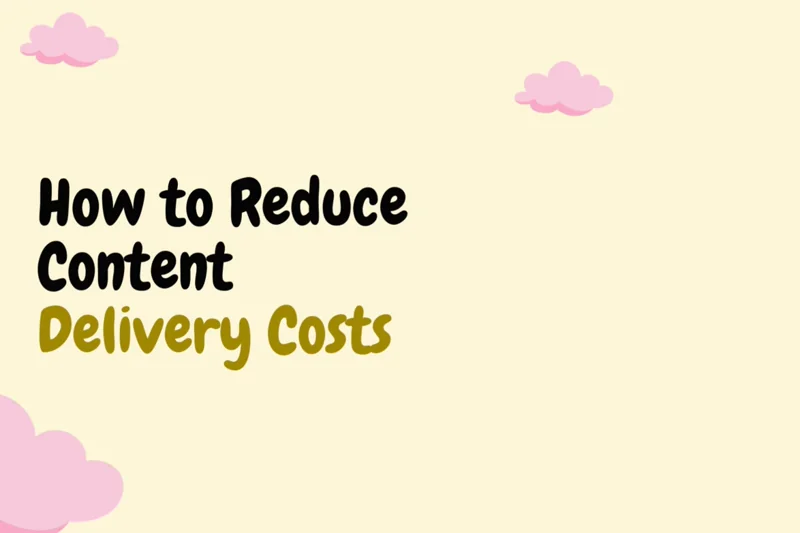Enhancing E-Commerce Websites Performance: How Multi-CDN Boosts Sales
The internet has evolved by leaps and bounds since its humble beginnings. These days, the performance of e-commerce websites is integral for business success. Research shows that 47% of people expect a web page to load in two seconds or less, and 40% will abandon a page if it takes more than three seconds to load. This directly impacts conversion rates, customer loyalty, and brand reputation. Addressing this challenge, Multi-Content Delivery Networks (Multi-CDNs) emerge as a game-changing solution. They optimize the delivery of content, meaning significantly reduced load times, enhanced user experience and, consequently, high sales performance. So, in this article, let’s talk about enhancements and see just how important it can be to focus on website performance!

Why is Performance Important for E-commerce Websites?
The performance of e-commerce websites is not just a matter of convenience but a crucial factor in business success.
Here’s why:

1. Direct Impact on Consumer Behavior
A significant portion of online consumers, about 82%, state that slow page speeds directly influence their decision to purchase. This statistic highlights a fundamental truth: the faster the site, the more likely consumers are to complete a purchase.
Similarly, speed directly affects shopping cart abandonment rates. When pages load slowly, especially during the checkout process, frustration mounts, and customers are more likely to abandon their carts. This abandonment represents not only a loss of immediate sales but also a missed opportunity for future customer engagement and repeat purchases.
2. Influence on Bounce Rates and SEO
The relationship between website load times and bounce rates is direct and significant. As the page load time goes from one to three seconds, the probability of a user leaving the site, or 'bouncing', increases by 32%. This trend continues as load times increase, with pages taking five seconds to load seeing bounce rates as high as 38%.
Bounce rates not only reflect user dissatisfaction but also influence how search engines perceive a website. Search engines like Google consider user engagement metrics, including bounce rates, as indicators of a site’s relevance and usefulness.
A higher bounce rate can signal to search engines that the content is not valuable or relevant to users, potentially leading to lower rankings in search results. This decreased visibility in search engines can significantly reduce the potential traffic to the site, impacting overall sales and conversions.
3. User Experience and Retention

The initial seconds of a user's interaction with an e-commerce site are the making or breaking factor. A page that loads within one second maintains a stress-free and controlled environment for the user. This swift response time sets a positive tone for the shopping experience, making users feel valued and respected.
In contrast, a delay beyond 10 seconds severely dampens user interest and drastically reduces the likelihood of them returning to the site. Therefore, the immediate perception formed by the user largely dictates their ongoing engagement with the sit
4. Conversion Rate and Revenue
E-commerce site speed is inextricably linked to conversion rates and, consequently, revenue. Faster websites see higher engagement levels, reduced frustration among users, and improved brand perception. This enhanced user experience leads to tangible financial benefits.
For example, one case study demonstrated that improvements in site speed resulted in a 7.6% increase in site-wide conversion, translating to a significant $6 million annual revenue increase. This showcases the profound impact that even minor improvements in site speed can have on an e-commerce business’s bottom line.
Common Factors That Affect Website Speed

Despite varying case to case, a lot of common factors can significantly affect website speed. It is how you address these factors that make the most impact on your website’s performance.
- Large Images and Media Files: High-resolution images and extensive media files are common on e-commerce sites but can significantly slow down page load times due to their large file sizes.
- Excessive HTTP Requests: Websites with numerous elements such as images, scripts, and stylesheets require multiple HTTP requests for each element, leading to increased load times.
- Unoptimized JavaScript and CSS: Heavy JavaScript and CSS files, especially when not minified or optimized, can considerably lengthen the time it takes for a page to become interactive and visually stable.
- Ineffective Caching Strategies: Lack of efficient caching mechanisms means that returning visitors may have to reload resources that could have been stored locally, increasing load times on subsequent visits.
- Suboptimal CDN Utilization: Not utilizing a CDN, or using a single CDN, can lead to slower content delivery, especially for users located far from the origin server.
- Geographic Content Distribution Issues: Serving all users from a single location can result in latency issues, particularly for those located far from the server, as data has to travel longer distances.
- Handling Traffic Spikes: E-commerce websites often experience sudden surges in traffic, especially during sales or promotional events, which can overwhelm server capacity and slow down the site.
- Security Threats like DDoS Attacks: Websites are vulnerable to distributed denial-of-service (DDoS) attacks and other security threats, which can drastically reduce site availability and speed.
- Lack of Redundancy and Failover Mechanisms: Dependence on a single CDN or server increases risk; if the server goes down, the website can become completely inaccessible.
- Slow Delivery of Third-Party Content: Relying on external sources for content such as ads, widgets, or embedded media can introduce additional latency, as this content is often loaded from different servers.
- Inefficient Handling of Redirects: Websites with numerous redirects can cause additional HTTP requests, increasing the total time required for a page to load.
- Mobile Performance Issues: Many e-commerce sites are not fully optimized for mobile devices, leading to slower load times and a poor user experience on these increasingly prevalent devices.
- Asset Delivery Inefficiencies: Efficiently delivering various assets like product images, videos, and user interface elements is crucial for user experience but can be challenging, especially for sites with extensive catalogs.
- Challenges in International User Experience: For e-commerce sites with a global customer base, ensuring consistently fast load times across different regions is a significant challenge due to varying distances from the server.
These are just the cusp of the iceberg, the rabbit hole runs deep, and for your website to stay at the top of its game, addressing these factors can yield sizable improvements.
Ways to Improve Your E-commerce Website Performance

We’ve already discussed how improving the performance of your website can have a sizable impact on user experience and boosting sales.
However, instead of targeting every aspect in roundabout ways, you should look to make improvements that have a lasting effect overall.
Here is how most of these work:
- Multi-CDN Approach: Utilizing multiple Content Delivery Networks (CDNs) can greatly enhance website performance. This approach ensures content is served from the nearest server to the user, reducing load times and improving reliability. In case one CDN faces issues, others can take over, ensuring consistent availability due to efficient load balancing.
- Effective Caching Strategies: Implementing caching mechanisms can significantly speed up load times for returning visitors. Techniques like browser caching, server-side caching, and content caching ensure that frequently accessed resources are stored locally or on the server, reducing the need to fetch them repeatedly from the original location.
- Minifying CSS and JavaScript: Reducing the size of CSS and JavaScript files through minification removes unnecessary characters (like whitespace and comments) without affecting functionality. This results in smaller file sizes and faster load times.
- Implementing Lazy Loading: Lazy loading defers the loading of non-critical or non-visible content, like images below the fold. This technique ensures that only the necessary content is loaded initially, speeding up the page load time for the user's immediate view.
- Optimizing Images: Compressing and resizing images can drastically reduce their file size without significantly compromising quality. This is crucial since images often constitute a large portion of page content on e-commerce sites. Serving them in next-gen formats like Webp or AVIF is also an important step in the process.
- Reducing HTTP Requests: Simplifying the site's design and minimizing the use of scripts and plugins can reduce the number of HTTP requests required to load a page. Using CSS sprites and combining files are also effective strategies to reduce requests.
- Using Asynchronous Loading for CSS and JavaScript: Asynchronous loading of resources like CSS and JavaScript can improve page load times. This allows the browser to continue loading other elements on the page while these resources are being fetched.
- Optimizing Mobile Performance: With the increasing prevalence of mobile shopping, optimizing for mobile is essential. This includes responsive design, accelerated mobile pages (AMP), and ensuring that the site is lightweight and fast on mobile devices.
- Database Optimization: For websites powered by a database (like those using CMSs), optimizing database performance is crucial. Regular maintenance, such as cleaning up old data and optimizing database queries, can improve efficiency and speed.
Regularly monitoring website performance and conducting speed tests can help identify bottlenecks. Tools like Google PageSpeed Insights, GTmetrix, and Lighthouse provide valuable insights into areas needing improvement.
{{promo}}
Conclusion
In conclusion, enhancing the performance of e-commerce websites is a multi-dimensional endeavor with far-reaching impacts on a business's success. The importance of website performance can no longer be understated in today's digital-first commerce environment.





.webp)
.webp)

